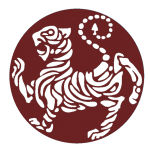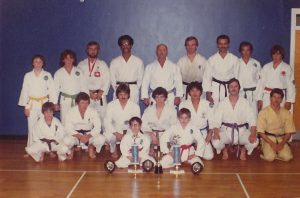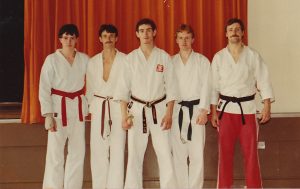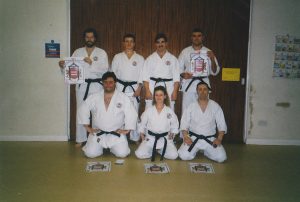I began Shotokan karate training in 1975 with Sensei Mike O’Brien at the National Sports Centre, Cardiff. With two friends, I met Mike who cut a very imposing figure – bull-like with high cheekbones, precision cut sideburns. He put us in the picture, but that didn’t prepare us for our first lesson. We were directed, along with the other white belts and juniors, to one side whilst all the black belts and senior grades took up the rest of the room. There was probably over 50 of us. Sensei O’Brien took the seniors whilst 3 black belts – Robert Taylor, Vaughn Johnson and Clayton Le Paul – took us. One would be in front demonstrating gyaku tsuki, gedan barai etc. counting off one to ten in Japanese, whilst the other two would be patrolling the lines, maintaining strict discipline, ordering us to only look to the front and emitting a kiai (deafening shout of intent) with every tenth technique. Anyone not giving 100% had to hit the deck and do ten press-ups on their knuckles. After thirty minutes of sweat and pain there was a chance of a break but no leaving the dojo. On to kata training – at least this was to a slow count but brain power was needed to remember basic sequences. The black belts and coloured belts sparred, which we really wanted to do, but we were not allowed to until we had learned our basics and kihon (basic) kata. At the end of the session we were brought together to do the ceremonial bow and yame (finish). I remember leaving the dojo with mixed emotions – I had never been so tired yet my heart rate was going through the roof. I was twenty-three years old and reasonably fit (having played football and athletics for over ten years) but I was not prepared for this, yet I knew it was for me. My two friends never went again.
I was drinking a lot in those days. In the 1970’s it was common to have a couple of pints of beer at lunchtime and then more in the pub in the evening, but I decided to stay ‘dry’ until after Friday’s training session – very unusual for me! As I remember, it got easier and once I was allowed to spar it became brilliant. Ironically it was safer to spar with a black belt, they had learned control, whilst beginners could be deadly. I started to get fitter and stronger. We would have lineups where, against a wall, you would have twenty karateka attacking you, one after another – jodan (head), chudan (middle) or gedan (lower). If your spirit was poor, the attacks would increase in intensity. Training would be relentless and there would be many black eyes, split lips and kicks to the groin. Sensei O’Brien would have a cassette player and only played Bob Marley as we sparred – we endured this for years! I remember a Christmas in the late 1970’s when we all went to Tito’s nigh club after training. Imagine twenty young men by the bar area with orange and tomato juices, adrenaline and blood still pumping from a full on session, when the DJ put on Bob Marley. Every one of us instinctively came to the yoi (ready) position then collectively we burst out laughing!
As we progressed through the grades we were expected to enter competitions, Sensei O’Brien wanted to see trophies and spirit. Cardiff karate club certainly had that with numerous champions – the pick being Robert Copeland and Gabe Operanta, truly exciting champions. The rules were semi contact but there were many injuries. I remember one competition in the old Top Rank in Cardiff where there were two ambulances outside attending competitors. It was reminiscent of a First World War casualty clearing station! Personally I didn’t have the speed, timing or athleticism to be any good, instead I concentrated on being a defensive counterpuncher with limited success – The height being in a KUGB final before losing to John Allen a tremendous fighter. Cardiff would field several teams and I remember competing in Farnborough, Coventry, Crystal Palace, Bridgend, Swansea and Wrexham.
Every couple of months we would attend a Dave Hazard course in Bridgend. In the 80’s Mike O’Brien started the World School of Combat at his dojo in Tonteg. Who could forget his assault course up Tonteg mountain! I attended a week seminar at Lancaster University with the KUGB greats Andy Sherry, Terry O’Neill, Bob Rhodes and Steve Cattle. The University was located in the Lancashire hills but I remember one day someone’s car been broken into and hearing the broad scouse accent of Sensei Terry O’Neil – “It’s disgraceful, I’ll be glad to be back in Liverpool!”
Training was relentless, we would train often with bad injuries so you didn’t get left behind. My worst was January 1982 when I had my cheekbone broken in three places. On the Tuesday I reluctantly went to the old Cardiff Royal Infirmary and after an x-ray I was put on a ward for an operation on Wednesday morning. I had 30 stitches in my head after a tool was used to fix the bones. After coming out of sedation on the Thursday I was told I was staying for the weekend. No way, because I had to be out on the Friday for my mother’s wedding! As well as the stitches I had a massive black eye, red raw cheekbone and because I hadn’t eaten since Monday I was very gaunt looking. The following Monday I trained. I like to believe it was dedication, but really it was because BBC Wales were filming us. The irony was I am seen only in the background, distinguishable only by a massive white bandage!
Gradings were held every 3 to 6 months where Mike O’Brien would sit Buddha-like as you were judged. Basics, kata and sparring. Next session would come the results with everyone fearing a ‘T’ ( temporary – a sort of fail), which although you could wear the next belt, wouldn’t look good on your license.
I achieved my 1st Dan Black Belt grade with Sensei O’Brien at the National Sports Centre on 1st April 1984. My partner that day was Robert Copeland, who was going for his 2nd Dan. I was so tired from basics and kata, doing Bassai Dai three times alone, that when I had to spar with Robert I was apathetic whether I passed or not. However, Robert drove me on with kicks and punches coming at me so intensely that if I hadn’t fought back with spirit I would have been hurt. Thank you for that Sensei Robert Copeland.
The club was very cliquey. You would tend to stick with your own grades because you started together. In our minds there was nothing worse than rising above your grade i.e. ‘you had to know your place’. This was the 70s and 80s. When I finally achieved black belt in April 1984 I wrongly thought I’d arrived, only to learn my journey had just begun. I remember a student, let’s call him ‘Dave’, well ‘Dave’ was purely a belt hunter – fair enough he never missed training and even went to Sensei O’ Brien’s other club so he could get those belts quicker. He would hang out with the other black belts before training and I felt (probably wrongly) that he felt it was beneath him to be with his peers. I remember being in the square with him – I think he was a 4th Kyu but in my opinion he hadn’t spent enough time in the ranks. Because he was junior to me in rank a certain leeway was accorded to him for his lack of control and as I was a black belt I was expected to handle it. Before we took to the floor, I remember Dave Morgan (as his second) saying I was only a counter puncher with no long range kicks. ‘Dave’ came at me and caught me full on with a kizama tsuki (front jab) to the face. I know accidents happen, but when I saw him smile wryly at Dave I was angry. The next moment as hajime (start) was called, for the first time in competition training, I let fly with a jodan mawashi geri (roundhouse kick to the head) which caught him full on the side of his face. He fell almost in slow motion into Dave’s ams, out for the count! I was chuffed to beans it worked, although later I regretted losing my temper. ‘Dave’ never trained with us again, so maybe his heart wasn’t in it and I did him a favour!
In 1990, Sensei O’Brien finished at the National Sports Centre and relocated to his dojo at home in Tonteg near Pontypridd.
In 1992, after suffering a couple of broken ribs, I decided it was time to quit. After 17 years training and with a new job I felt it was time to hang up my belt. They say “never say never” and so, later in 1992, I decided to train again. Mike O’Brien’s club was not an option – I couldn’t afford any more injuries, so I started with the Higashi Wado Ryu club at Cardiff University. The chief instructor was Sensei Bryan- excellent training and colleagues. I was quite content to stay with Wado Ryu until I met Sensei Ken Tucker, doing his kata in the University gym about 1995. He kindly invited me to train where he trained – Cardiff Traditional Karate at Plasnewydd and Roath leisure centres. The chief instructor was Bernard Downey. From this point I was shown karate as taught by the Japanese traditionalists.
I will stress that the prior years of training ie sparring, keep fit, competitions etc were not wasted. I became fitter and adopted a healthier lifestyle. However, competition or sparring does not teach self defence. Simple logic told me competition rules and sparring teach you not to hit the face, groin or kneecaps. Yet if you are learning self defence, these are the targets to aim for. Previously I was never taught how to get out of strangleholds, do groundwork (fights often end up on the ground) etc. Classes were different, no longer 20 minute warmups – would one warm up when attacked? No keep fit, if you want to do press-ups, sit-ups etc go to circuit training. This was pure karate with an emphasis on the kata Bunkai (applications).
My first year I felt like a beginner again. This style of Shotokan demonstrated that you didn’t have to be strong, fit or athletic but imaginative and trust the techniques. I realised that doing hundreds of gyaku tsuki or gedan barai etc did not make you faster or stronger but adversely affected your joints. Traditional karate showed that the little guy could win. I learned that a fight didn’t end with an ippon score but on the floor. I learned throws, wrist locks and armbars which were all in the kata but never previously explained. There were some very fine karateka, as well as Sensei Ken Tucker, there was Martyn Harris (who went on to form his own karate academy) and Doug Hunt, who had the biggest hands I’ve ever seen but was truly a gentle giant.
In November 1998 I achieved my 2nd Dan, doing bunkai of Hangetsu kata. They say all good things come to an end and Sensei Bernard decided to move away from Shotokan to a more flexible almost Chinese style of fighting. Not for me – I tried, but once a Shotokan karateka ………. so I started with Martyn Harris at his dojo in Pentwyn in Ryukyu Kempo karate, similar to Shotokan with emphasis on pressure points. It was a fine club and on the 24th July 2005 Sensei Martyn presented me with my 3rd Dan. I was very proud and pleased with such fine karateka as colleagues.
In 2010 I started training again with Sensei Ken Tucker who taught traditional Shotokan karate in his own club at Cardiff University. Once again I was indebted to be training alongside such fine karateka as Peter Woodward, Rhys Tucker, Meirion Davies, Kim Maxwell, Lewis Turner, Harry Williams and others. In 2016 the club relocated to Caerphilly in a superb dojo. The club is thriving now with new members. I am amazed at the attitude and intelligence of our karateka. Sometimes I watch them doing their applications to kata and I realise that after so many years I know so little. At the age of 65 these students actually motivate me, such are their endeavours and enthusiasm.
Karate has been very important to me, enabling me to cross this ‘catastrophe’ called life. I have made many friends and adopted a healthy lifestyle. I would like to thank all karateka who have taught me, cajoled me, trained me and fought me. I have learned something from you all. Particular thanks go to Senseis Mike O’Brien, Ken Tucker and Bernard Downey.
I would like to thank my wife Marianne for her support and understanding of my journey through the years. Thank you.
Clive Lewis
October 2017




